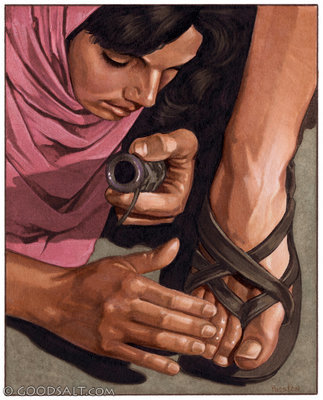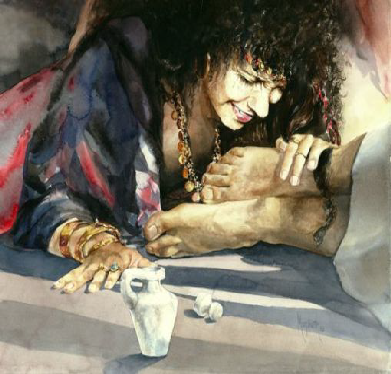|
A
question frequently posed:
How many women in the Gospels had anointed the Lord with myrrh?
According to one version, it was three women (as Origen believed);
according to another version, two (as St. Chrysostom believed), and to
yet another version, it was one (as believed by Apollinarius and
Theodoros).
But according
to the most paradoxical version, the sinful woman, the prostitute in
Luke 7:36-50, is identified in Matthew 26:6-13, in Mark
14:3-9 and in John 12:3 as Mary, the sister of Lazarus! According to
this version, Mary, the sister of Lazarus, had anointed Jesus with myrrh
twice; the first time at the house of Simon the Pharisee in Galilee,
upon repenting of her sins, and the second time at the house of Simon
the (former) leper in Judea, in Bethany, a little while before Christ’s
Passion.
For this paradoxical version we have only the following comments in
response:
Christ had instructed His disciples that when entering a city or
town, they should examine who is a worthy person there, and stay with
them (Matt. 10:11). Doesn’t
it therefore stand to reason that – in order to avoid giving cause for
accusation – He would have stayed at the home of Lazarus’ sisters,
Martha and Mary? Would He
have stayed there, if Mary was a prostitute?
Wouldn’t the Jews, who were
putting Christ’s every move through a fine sieve, have accused Him of
staying at the home of a prostitute?
We therefore regard this version as totally unacceptable.
We consider as correct the opinion of those interpreters (eg St.
Chrysostom), who maintain that - according to the Gospels - TWO women
had anointed the Lord with myrrh: the prostitute in Luke 7:36-50 at an
earlier time, in the house of Simon the Pharisee in Galilee, and Mary
the sister of Lazarus in Matt. 26:6-13 and Mark. 14:3-9 where she is
mentioned anonymously, (but also belatedly by the Evangelists, because
it appears that this specific incident had made Judas decide to betray
Christ) and in John. 12:3, where she is mentioned by name, shortly
before the Passion, at the house of Simon the (former) leper, in Bethany
of Judea.
That the anonymously mentioned woman in the Gospels of Matthew and Mark
is in fact Mary, the sister of Lazarus as named in the Gospel of John,
is clearly evident, if one simply compares the narratives of Matthew and
Mark with the narration of John. The common characteristics are many and
serious, whereas the differences are few, detailed and easily settled.
The fact that – for example -
according to both Matthew and Mark, the myrrh was poured on the head of
Jesus, is not incompatible with what John had written, i.e.,
that it was poured on the feet
of Jesus, inasmuch as the
one does not preclude the other, because myrrh was usually poured over
the guest's head as well as his feet. Mary,
being a noble and grateful soul and in her desire to show her love for
Christ and her gratitude to Him for resurrecting her brother (Lazarus),
took a “liter” - about three hundred and twenty-five grams - of
extremely costly myrrh, called nard, and anointed Christ. .
According to Matt. 26:7 and Mark. 14:3, the myrrh was poured on the head
of Jesus, while according to John. 12:3, the myrrh was poured onto
Jesus' feet.
A seeming contradiction of course, and certainly not a real
one. As already mentioned, myrrh
was poured on both the head and the feet of a guest; it was customary at
banquets to anoint the head with oil.
The practice of anointing head and feet is also evident, when Simon the
Pharisee had invited Jesus to dine at his home in Galilee but had not
anointed His head with oil (unlike the prostitute who had anointed His
feet with myrrh) where the Lord said to Simon, “You did not
anoint My head with oil; she however had anointed My feet with myrrh”
(Luke 7:46).
In observance of
the custom that prevailed at banquets, Mary had poured a part of the
myrrh on the head of the Lord and then with the rest of the myrrh she
anointed Jesus’ feet. The
evangelist John highlights the latter (the anointing of feet with myrrh),
because the anointing of feet was of greater worth; Mary was bestowing
an even greater honor to Jesus - and making her love for the Lord even
more evident - as well as her humility.
For Jesus, the anointing of His feet was honorary, while for
Mary it was humiliating. But Mary most certainly did not find this act
humiliating, but rather honorary for her person.
Finally, in favor of the version that the woman referred to in Matthew,
Mark and John is the same one, is supported by the fact that all three
report that this event took place in the Judean township of Bethany,
whereas Luke mentions a sinful woman (a different woman) and that the
event he describes did not take place in a township, but a city (Luke
7:37), quite possibly Capernaum!
Tuesday, 27/4/2021 - Holy Week, commemoration of the woman who
anointed Jesus' feet
Translation by A. N.
Greek Text |



